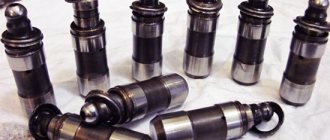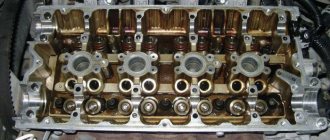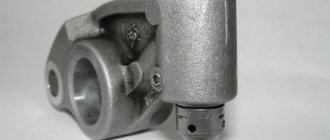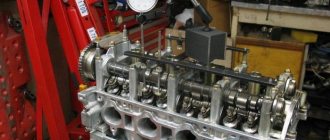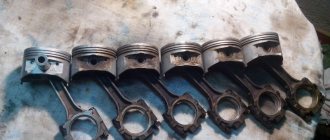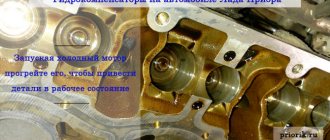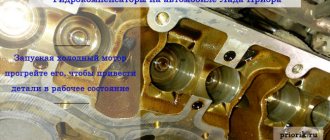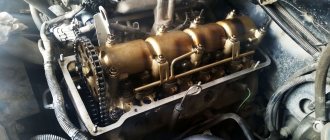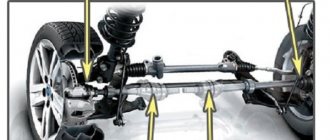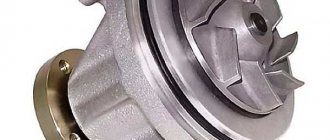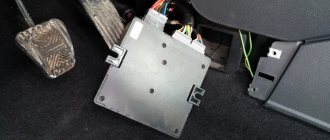The internal combustion engine is the most complex unit in a car, the efficiency of which depends on the fine tuning of each mechanism associated with it. An example of this is the design of the gas distribution mechanism. It ensures that the intake and exhaust valves open at the moment when the piston moving in the cylinder performs the corresponding stroke.
Everyone knows that during the operation of an internal combustion engine, all its parts heat up. At the same time, metal products expand. And when the motor is running, many processes in it are performed in a matter of seconds. In this case, every micron of gaps plays a role. If the valve opens a little earlier or later, this will significantly affect the efficiency of the power unit.
For this purpose, in old engines the gaps were set between the valve pusher and the timing shaft cam. In modern engines this process is simplified as much as possible. To be precise, this was no longer necessary, since engineers developed such a part as a hydraulic compensator.
What can a hydraulic compensator do?
The hydraulic compensator is installed between the valve tappet and the camshaft cam. This part independently regulates the size of the thermal gap. As the name implies, automatic adjustment occurs due to the hydraulic action of oil on the compensator elements.
If previously this function was performed by mechanical devices that constantly needed adjustment or replacement, these elements perform the work automatically, making life easier for the car owner.
A little history
In old engines, for example, Soviet classics, there were neither hydraulic nor mechanical thermal gap compensators. For this reason, routine vehicle maintenance included mandatory adjustment of this parameter. Manufacturers often set an interval of 10 thousand kilometers.
When this procedure was performed, the valve cover was removed and the size of the thermal gap was adjusted with a special probe and wrench. Not every owner could carry out this procedure independently, and if this was not done, the engine began to run noisily and lose its dynamic properties.
In such engines, the valves had to be changed every 40-50 thousand mileage, which added headaches to the owners of such cars. The design needed improvement, so a washer of a certain thickness began to be installed between the pusher and the cam. Now it was not the valve stem itself that was wearing out, but this part.
Despite this, adjustment still had to be made, and repair work was reduced to a simple replacement of the washer. Some manufacturers still use similar parts in their car engines.
Despite the significant improvement in the operation of the gas distribution mechanism, maintenance of the unit still had to be carried out quite often.
The mechanical compensators were replaced by an original mechanism that adjusted the gaps automatically. The hydraulic compensator system has increased the engine maintenance interval by almost three times, and now you need to look under the valve cover much less often - no more than every 120 thousand kilometers.
Verification methods
Now the motorist is faced with the task of finding out whether the expansion joints on his car are working or not. What is the best thing to do in such a situation?
There are two verification options.
- The first option involves removing the valve cover. The method is more visual and allows you to almost certainly guarantee the correct diagnosis. But implementation is more difficult due to dismantling work;
- The second option does not require the elements to be dismantled. But here you need good hearing. To improve it, it is better to use a phonendoscope. By listening to the operation of the main engine in different modes, you can find the source of the problems.
Which option should I choose? It's up to you to decide.
Both verification methods have their strengths and weaknesses. For a beginner in such matters, I would recommend starting by listening to the hydraulic compensators. If wiretapping does not yield anything, then open the valve cover and more clearly examine the condition of the elements.
Wiretap check
The preparation for the procedure is extremely simple. You need to place the car on a flat surface, open the hood, start the engine and listen.
Even perfect hearing does not always allow one to clearly recognize a non-working compensator. It is better to take an auxiliary medical instrument to help. It's not difficult to find.
And here we will consider several situations. Depending on the result of the check, we will draw appropriate conclusions.
- After starting the engine, the noise appeared at first, but disappeared after a few seconds. Everything is fine with compensators. Lubricant just temporarily leaked out of the cavities of the main body. The engine turned over and filled them;
- The speed is idle, and the noise from the compensators is intermittent. As soon as you raise the speed, the noise goes away. There is a problem. It lies in the bushing or blockages;
- The engine is warm, the speed is idling, the noise is continuous. By increasing the speed, the noise disappears. This means that the gap has increased;
- The symptoms are similar to the previous point, only at low speeds there is no noise, but at high speeds there is. Here you are faced with foaming of the oil;
- One or several knocking noises occur at once, regardless of engine speed. Any of the above malfunctions are possible here.
By applying the wiretapping tool one by one to the area where each of the compensators is located, you can understand where exactly the problem is.
If the noise of one HA differs from the others, you have found the source of trouble. All that remains is to figure out the reasons and eliminate the malfunctions.
Disassembly check
To check these elements for their functionality, you can remove the valve cover. Next, you will have to rely on your own feelings when checking elasticity.
You will have to turn the crankshaft using the center nut to do this. This will set the shaft in motion.
When the pusher cam is directed in the direction opposite to the main body, check the elements one by one for their elasticity, whether there is free play.
You can use your hands or available tools. When the compensator is loose and moves too softly, it is faulty. Needs renovation.
Operating principle of hydraulic compensator
The hydraulic compensator has the following device:
- A metal case in which all elements of the mechanism are installed;
- A plunger pair (read more about the operating principle of this element using the example of a plunger pair of a high-pressure fuel pump ), which operates on oil pressure;
- Ball – acts as a check valve;
- Spring - allows the plunger valve to move into place when the part is at rest.
The hydraulic compensator operates in the following two modes:
- The camshaft cam is turned away from the working surface of the compensator. There is no pressure on the plunger spring, so it lifts it so that it is pressed against the cam. The place where the plunger was located is filled with oil. The fluid pressure is equal to the pressure in the engine lubrication system;
- When the cam rotates toward the valve, it moves the plunger, pushing it down toward the valve stem. The spring stiffness is selected so that, with minimal effort, the valve installed in the cylinder head opens in accordance with the position of the cam. To increase the pressure on the valve stem, the volume of oil located in the sub-plunger space is used.
Thus, the hydraulic compensator “adjusts” not only to the thermal expansion of the timing parts, but also to the wear of the cams and valve stems. Such an original solution eliminates the frequent adjustment of the mechanism to these changes.
The operation of the hydraulic compensator is briefly described in this video:
Hydraulic compensators. How do hydraulic compensators work and why do they knock?
Hydraulic compensator location
To find a hydraulic compensator in an engine, you need to understand the design features of the engine. In standard modern power units, the head is located above the cylinder block, and a camshaft is installed in it. Its cams drive the intake and exhaust valves.
Hydraulic compensators, if present in this engine modification, will be installed just between the cam and the valve stem. The hydraulic compensator ensures a constant clearance between the valve and the cam, regardless of the temperature (and, of course, valve stem expansion) of the valves.
Correcting the situation
It becomes very simple to finish what you started after identifying all possible causes:
- If the reason why the hydraulic compensators are knocking when cold is the products themselves, then they will have to be replaced simply.
- If there is an incorrect amount of oil, add it or, conversely, drain the excess.
- When clogged, the filter element is replaced.
- The same should be done if damage to the pumping equipment is detected.
If the car owner was unable to identify any obvious signs of such noise occurring when operating his car, then it is recommended to purchase and use higher quality oil. If this does not bring results, then there is only one way out - sending the vehicle to a good service station, where more experienced specialists will be able to select the “optimal treatment”.
For long-term operation of the car, it is important not only to visually inspect the mechanisms, but also to listen to the sounds that it makes. For example, by ear you can diagnose the case when hydraulic compensators are knocking
To facilitate the operation of the car and eliminate the need to regularly adjust the valve clearance, manufacturers have developed and began to commercially use hydraulic compensators. However, their use not only makes life easier for the car owner, but can also cause concern about what to do if there are extraneous sounds from the engine compartment.
The most common reason why hydraulic compensators knock is oil.
The car owner needs to pay attention to the following factors that can cause knocking of hydraulic compensators:
- the oil must comply with the manufacturer's recommendations
- Oil changes must be done on time
- The oil filter is replaced at the same time as the oil change.
- the oil must match the climatic conditions
The most important thing when choosing an oil is that its viscosity matches the manufacturer's recommendations. Hydraulic compensators will knock if:
- oil is too viscous
- oil is too thin
If the oil is too viscous, the hydraulic compensators usually knock when cold, since insufficient oil is supplied through the channels. As the oil heats up, it becomes more liquid and can easily fill the entire system. Therefore, the knocking when hot usually goes away.
If the oil is too thin, then on some cars a situation arises that the oil pump is not able to create optimal pressure in the system. As a result, oil starvation occurs and the knocking of hydraulic compensators, which is more clearly audible on a warm engine, occurs. If the oil pump breaks down, a similar situation arises.
The same situation can arise if the oil does not match the climatic conditions.
To eliminate the knocking of hydraulic compensators in this case, it is necessary to change the oil. If the oil change is carried out in a garage, then it is necessary to ensure that the oil fully complies with the requirements of the car manufacturer.
What are the types and types of hydraulic compensators?
The operating principle of one type of compensator was described above. Engineers of each individual car manufacturing company can use other types of hydraulic compensators:
- Hydraulic pusher, which is described above. It is installed between the camshaft cam and the valve stem;
- Hydro support;
- Older engines used a hydraulic mount, which was installed in the rocker arms or valve lifter arms;
- Roller hydraulic pushers.
Most automakers are trying to move away from hydraulic supports, since the design of hydraulic pushers is as simple as possible. Although a device such as a gas distribution mechanism may not allow the use of this type of compensator. The photo below shows the location of the hydraulic compensator depending on the type of engine timing belt.
Historical excursion
Hydraulic compensators, also known as hydraulic pushers, or in common parlance “hydriki”, appeared quite a long time ago. Let's look at why compensators are needed and how they appeared in the engines of many cars.
Drivers largely owe their appearance in the design of gas distribution mechanisms of cars to Japanese auto engineers, since it was they who began to massively use “hydraulic valves” in the design of engine timing systems. At that time, when designing an internal combustion engine, much attention was paid not only to its main components (crankshaft, pistons, connecting rods), but also to the details of the gas distribution mechanism. Engineers gradually “brought” previous generations of their power units to perfection. Thus, hydraulic pushers replaced the usual mechanical pushers.
Pros and cons of a hydraulic compensator
Hydraulic compensators have many advantages. These include:
- Low motor noise;
- No need to adjust thermal clearances caused by natural valve wear;
- Does not require maintenance;
- Provides constant pressure of the valve stem to the camshaft cam, which ensures high efficiency even of a heavily worn gas distribution mechanism;
- Stable dynamic characteristics of the old motor.
However, despite the abundance of advantages, advanced technology also has several major disadvantages:
- Hydraulic compensators use oil pressure, and the holes in them are so small that thick lubricant simply physically cannot get inside, especially if the system has not yet warmed up. For this reason, you need to fill the engine with high-quality oil - most often synthetic. But a motor with high mileage, on the contrary, needs thicker lubrication - the O-rings are already a little worn, so synthetics are not able to create a high-quality oil wedge. Because of this, the dynamics of the motor decreases;
- Even if synthetics are used, the oil still needs to be changed more often, as over time it loses its fluidity;
- If it fails, you will need to buy the exact same part, and not a cheaper analogue (the location of the hydraulic compensator does not allow the use of a design other than the one provided by the manufacturer);
- Since breakdowns occur at later stages, repairs will cost more than with routine internal combustion engine maintenance;
- Sometimes, due to poor quality of lubricant, the plunger may become clogged, which will lead to incorrect operation of the mechanism.
The biggest disadvantage is the demands on the quality of the oil. If a motorist ignores the requirements for this parameter, very soon he will have to fork out for the purchase of new expansion joints. In the case of motors that have reached a long service life, mechanical analogues would be a good alternative - they prevent valve wear and at the same time regulate the thermal gap.
The other side... supports
The main reasons for the failure of the hydraulic compensator (HC) are contamination of the engine oil channels and wear of the working surfaces of the check valve and plunger pair, manufactured with a high degree of precision. Contamination is caused by the use of inappropriate oil, failure to comply with oil change intervals, or a malfunction of the oil filter that allows dirty oil to pass through the bypass valve.
As the seating gap in the plunger pair increases, oil leakage from the high-pressure chamber increases. The hydraulic compensator loses its “stiffness”, so the efficiency of transmitting the force of the cam to the timing valve stem decreases. The same thing happens when the check valve of the high-pressure chamber wears out. Malfunctions in the engine lubrication system slow down the filling of the main gearbox with oil and do not allow gaps in the timing belt to be absorbed.
The internal volume of the HA must be filled with oil. An empty or partially filled ("aired") hydraulic compensator does not fulfill its main purpose - eliminating gaps in timing parts. As a result, shock loads occur, which manifest themselves as a characteristic knock. This leads to accelerated wear of timing parts and deterioration of engine performance. Breakdowns can also be caused by particles of worn parts getting into the hydraulic fluid with oil: the unit can jam. Depending on the position in which this happened, large gaps will either appear in the timing belt, or the valves will be “pinched” (the load on the camshaft increases, power decreases, etc.).
To avoid this, you must:
- control and maintain the internal cleanliness of the engine - change the oil and oil filter within the time limits recommended by the car manufacturer, with a reduction factor of 0.6 - 0.9, taking into account the operating conditions of the vehicle;
- Flush the engine before the next oil change, using slow-acting “mileage” flushes. If the internal surfaces of the engine are contaminated (which is discovered, for example, when removing the timing case), it is not recommended to use quick-acting flushing agents, since exfoliated pieces of dirt with the flow of oil can get into the internal cavities of the compensators and damage them.
You need to know that small gaps between the moving elements of the hydraulic compensator determine the use of high-quality low-viscosity oils in the engine - synthetic or semi-synthetic (SAE 0W40, 5W40, 10W30, etc.). It is not recommended to use mineral oils (for example, SAE 15W40) due to their high viscosity and tendency to form tar deposits.
How to choose hydraulic compensators
If the engine timing belt is equipped with hydraulic compensators, then the question of whether to buy new parts or not is not worth it - definitely buy. Otherwise, the phase distribution in the power unit will not work correctly - the cam will not be able to open the valve in time, and the motor will lose its efficiency.
If it is not known which models are installed in the engine, then the search for hydraulic compensators is carried out by the VIN code of the vehicle or by the engine model in the catalog. It is worth considering that some sellers call any expansion joints pushers. When selecting a part, you can also indicate to the seller the type of gas distribution mechanism (SOHC or DOHC - read about the difference between such modifications here ).
When choosing a budget or original compensator, you should also pay attention to its technical characteristics - weight, spring stiffness, etc. (if they are indicated in the catalogue). If the valves have a small stroke, then lightweight compensators can be installed.
Which hydraulic compensators are better?
When choosing this part, you should remember: the budget analogue more often requires replacement. But even among the so-called original spare parts there are fakes. To avoid wasting money on low-quality products, pay attention to manufacturers who have proven themselves in the auto parts market.
Also note that automakers do not make hydraulic lifters themselves. They use the services of individual companies, so this part does not exist from the manufacturer - they are purchased from independent companies and sold like the original, but more expensive.
You can choose the following manufacturers:
- German manufacturer INA. Hydraulic compensators are of excellent quality and almost never fail ahead of schedule;
- Another German company is Febi, but the quality of their products is slightly lower than that of the previous representative. The country of manufacture is indicated on the packaging of the part - you should pay attention to this, since Chinese factories do not always produce premium products;
- SWAG is a company whose services are used by manufacturers of the VAG group (which brands of cars are part of the concern were discussed a little earlier ). Parts from this company are in the budget category, but fakes are much more common;
- Below in the ranking are Spanish-made hydraulic compensators AE or Ajusa. The consequences of the relatively low cost are a short working life (about 10,000 mileage). Another drawback is the high demands on the quality of the oil.
Advantages and disadvantages
Hydraulic compensators allow you to avoid many technical problems during engine operation. There is no need to adjust the thermal gap, for example, using washers. Hydraulic pushers also reduce noise levels and shock loads. Smooth and correct operation reduces wear on timing parts.
Among the advantages there are also disadvantages. Engines that use hydraulic compensators have their own operating characteristics. The most obvious of them is uneven operation of a cold engine at startup. Characteristic knocking sounds appear, which disappear when the temperature and pressure are reached. This occurs because the oil pressure is insufficient at startup. It does not enter the compensators, so there is a knock.
Another disadvantage is the cost of parts and maintenance. If replacement is required, it should be entrusted to a specialist. Also, hydraulic compensators are demanding on the quality of the oil and the operation of the entire lubrication system. If you fill in low-quality oil, this can directly affect their performance.
Diagnostics and replacement of hydraulic compensators
A malfunction of hydraulic compensators is diagnosed by their knocking sound. To make sure that the characteristic sound comes from the compensators, use a phonendoscope.
If a malfunction of the hydraulic compensators is determined, they are dismantled using a magnet, but this is in the case of a clean and serviceable timing mechanism. It happens that a part gets stuck in the seat, which is why dismantling must be done with a special puller.
There are several ways to check the performance of the hydraulic compensator. First, an external inspection of the part is carried out to find defects. The wear on the working surface of the element will be visible to the naked eye. Secondly, there are collapsible compensators. In this case, you can inspect the internal elements to determine the degree of wear.
Another diagnostic method is to pour oil into the dismantled compensator. It will be impossible to squeeze the working part with your fingers. Otherwise, it should be replaced.
Why are hydraulic compensators knocking?
Knocking of hydraulic compensators can be observed even in new cars, so this is not always a symptom of some kind of breakdown. This effect can be observed both on an unheated internal combustion engine and on a power unit that has already reached operating temperature. Regardless of why this happens, this noise should never be ignored, since this problem will certainly affect the performance of the gas distribution mechanism.
Let's consider the common causes of knocking of hydraulic compensators in different engine states.
Reasons for the knocking of the hydraulic compensator “on hot” (when the engine is warmed up):
This effect in a warm engine appears due to:
- Poor quality motor oil, or it has not been changed for a long time;
- A dirty oil filter - because of it, the oil does not reach the hydraulic compensators at the required pressure;
- A failed oil pump (or its performance has decreased, causing it to create insufficient pressure in the engine lubrication system);
- Worn hydraulic compensator plungers and sleeves, which leads to oil leaks (in this case, the parts are changed);
- Failure of the hydraulic compensators themselves.
Reasons for the knocking of the hydraulic compensator “when the engine is cold” (when the engine is not warmed up):
The knocking of hydraulic compensators can also only occur when the power unit is not warmed up, and as it warms up, this sound disappears. Here are the reasons for this:
- The hydraulic compensator channels are dirty. Since cold oil is more viscous compared to already heated lubricant, it is extremely difficult for it to pass through a blockage in the channel, but as it heats up, the oil becomes liquid and is easier to press;
- Incorrectly selected oil. Typically, inexperienced motorists encounter this problem. If a thicker lubricant is selected, the hydraulic compensators will definitely knock;
- The hydraulic compensator valve does not hold pressure, which is why when the engine stops, the oil goes into the sump.
If the knocking sound of hydraulic compensators appears when the engine reaches high speeds, then here are the possible reasons for this:
- The oil level in the crankcase exceeds the maximum level, which causes it to foam;
- The oil level in the crankcase is too low, causing the oil pump to suck in air;
- The oil receiver is damaged due to the sump hitting an obstacle on the road (for this reason, experienced motorists recommend installing sump protection on the car, which is discussed in detail in a separate article ).
If knocking occurs in one or more valves, regardless of crankshaft speed, this may be due to the fact that the gap between the tappet and the cam (located on the camshaft) has increased. To eliminate this malfunction, the cylinder head is removed, the cams are aligned vertically one by one (the thin part of the “droplet” should be at the top), and it is checked whether there is a gap between the pusher and the cam.
The stroke of the hydraulic pusher is also checked (the element being tested is pressed with a wooden wedge). If one of the hydraulic compensators works noticeably more freely than the others, then it needs to be replaced or disassembled and its elements cleaned.
To eliminate the knocking noise of recently replaced expansion joints, you will need to flush the thin channels in the lubrication system. To do this, you can use special tools, for example, Liqui Moly Hydro Stossel Additiv. It is added to the car's lubrication system after the engine has warmed up. The effect of the product occurs after 500 kilometers.
Such additives should not be used immediately or as a preventive measure, as the substance can increase the thickness of the oil, which can adversely affect the lubrication of the entire engine.
If the lubrication system is heavily contaminated, before installing new compensators, it is necessary to flush it with special oil. In rare cases, disassembly of the power unit will be required. For this reason, you should not neglect the rules for replacing internal combustion engine lubricant. This is discussed in more detail in another review .
Repair
Not every hydraulic pusher can be restored to working condition. But sometimes the replacement period can be noticeably delayed. Sometimes you can't do without it. The spare parts catalog does not always contain the required item. There are at least 3 ways to extend the life of the pusher:
- Mechanical cleaning. It will take time and considerable skill to disassemble the cylinder head and remove the hydraulics. But the result will be noticeable immediately. No need to pour chemicals into the engine.
- Changing the filter and oil. During the procedure, the system should be flushed in the traditional way. To do this, you need to fill in the flushing lubricant, hold it, drain and fill the system with regular oil.
- Application of flushing compounds. There are two popular options: Liqui Moly Hydro-Stossel-Additiv and BG103. You need to do everything strictly according to the instructions. Otherwise there will be no effect.
Flushing with Liqui Moly
The second and third options will help to revive hydraulic compensators if the oil channels are clogged. Other types of faults will have to be dealt with point by point. Hydraulics knock when mechanical damage occurs due to a disruption in the circulation of lubricant in the system. The situation can be corrected, but this requires proper diagnosis and repair.
How to extend the service life of hydraulic compensators
Basically, the working life of hydraulic compensators does not depend on the vehicle speed, crankshaft speed or any driver actions. The only thing that can significantly extend the service life of hydraulic compensators is the use of the engine oil recommended by the manufacturer. Read more about how to choose the right lubricant for a car that is operated in a special climatic region here .
Every motorist should carefully monitor the timely replacement of engine lubricants. Some car enthusiasts think that it is enough to simply add fresh oil, and over time it will be renewed. With this approach, the hydraulic compensators will knock much earlier than the manufacturer indicates.
The performance of the hydraulic compensator is reduced due to the fact that its valve becomes clogged. This happens due to the poor quality of the oil (there may be foreign particles in it). For this reason, it is better to change the oil rather than top it up if the level keeps dropping.
Malfunctions
1. Use of low-quality oil and/or untimely replacement of fuel and lubricants.
When cheap and low-quality oils are poured into the engine, the hydraulic compensator parts are subject to premature wear: the oil channels and the compensator valve (ball) become clogged, which is why the compensator does not close completely. In addition, with low-quality oil and improper operation of the plunger pair, oil leaks and incorrect clearance selection often occur.
2. Untimely replacement of fuel and lubricants.
Rare engine oil changes are also one of the reasons for knocking compensators. Oil that has lost its working properties is prone to burning and coking, which is why deposits on the walls of the channels interfere with the normal passage and outflow of oil from the compensators.
3. Insufficient amount of oil in the system.
How often should hydraulic valve compensators be replaced?
It is extremely rare to repair or change hydraulic compensators. These parts are located in the timing mechanism, and frequent replacement or maintenance would be quite problematic. The manufacturer has thought through these parts so that with proper scheduled maintenance of the power unit there is no need to climb into the hydraulic compensators.
The working life of the parts is indicated by the manufacturer. Basically it is within 200-300 thousand kilometers. But this is only if the motorist carries out the required car maintenance in a timely manner.
How to wash the hydraulic compensator yourself
Even a novice motorist can handle this job. The main thing is to adhere to a certain sequence. But you shouldn’t do this yourself if the car is still under warranty.
First of all, you need to make sure that there is really a need for flushing the expansion joints. If engine problems are related to this, then before carrying out the procedure it is necessary to let the car sit for at least a day so that the oil completely drains into the pan. To wash hydraulic compensators, you will need three five-liter containers (their volume depends on the size of the parts being washed). They are filled with 92-grade gasoline, kerosene or diesel fuel.
Next, the cylinder head cover is removed, and the axles on which the rocker arms are attached are dismantled. In different car models, hydraulic compensators are removed in their own way, so you need to clarify how to do this correctly in a particular case.
The next step is to check the performance of the hydraulic compensators. The failed part must be replaced with a new one. If you press on the part with a wooden wedge and it moves too freely, then most likely the element needs to be replaced.
The washing itself is carried out in the following sequence:
- The axles on which the rocker arms are attached are removed;
- To remove the compensator, you can use a magnet. When dismantling, it is important not to damage either the part or its installation location;
- Each part is lowered into the cleaner;
- To clean, you need to slightly remove the hydraulic compensator from the liquid and press the plunger (you must first press the valve ball so that it does not work) until it has more or less free movement;
- The same procedure is carried out in the second and third containers.
The engine parts are assembled in the reverse order, but the washed hydraulic compensators must be dry. After assembly, the power unit is started and idled for several minutes to allow the engine oil to circulate properly throughout the system.
Procedure for installing hydraulic compensators
The sequence of installation of hydraulic compensators depends on the car model, because the engine compartment can be organized in its own way. But in many cars this scheme is as follows:
- All equipment located above the valve cover is dismantled, because it will need to be unscrewed and removed without damaging other elements (for example, the fuel system or ignition);
- The air filter is also removed, since it will also prevent the removal of the cover;
- The throttle cable is disconnected and the valve cover is unscrewed;
- The counter washer installed on the camshaft sprocket is flared;
- The asterisk is set in such a position that the marks coincide;
- The sprocket nut is unscrewed, and this part is fixed with wire;
- The camshaft bed fastening is dismantled. It is removed, and along with it the camshaft;
- The rockers are dismantled (it is important to remember the sequence of their installation, so it is better to immediately put them in such a sequence that the position of each of them is remembered);
- The cams are unscrewed, after which the bushings of the adjusting bolts are carefully removed;
- If necessary, the surface on the valve boss seats is ground in order to ensure maximum tightness;
- The cylinder head support washers are pressed using a special tool (depressant);
- The rocker arms are removed;
- The hydraulic compensator is being replaced.
The entire structure is assembled in reverse order. After replacing the hydraulic lifters, be sure to install a new valve cover and tighten the studs with a torque wrench. Here is a short video about how this work is done correctly:
replacing hydraulic compensators without removing the head without special tools Cadet, Vectra, Lanos, Nexia
